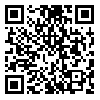BibTeX | RIS | EndNote | Medlars | ProCite | Reference Manager | RefWorks
Send citation to:
URL: http://refahj.uswr.ac.ir/article-1-1985-en.html
Objective: This article investigates the affect of Action Space Model on behavior in social dilemma situations. Social dilemma, in rational choice approach, refer to conflict between social interest and collective interest, in witch following self interest from most of the people lead to losses of all the people (among whom select self interest). Many factors affect on behavior in social dilemma situation, and one of them is Action Space Model (proposed by Masoued Chalabi), that is surveys the affect of norms and relations governing in Parsonsian four extreme points (AGLI) on behavior in social dilemma situations. Chalabi (in continuation of some thinker such as Burns) critics the mainstream of Game Theory and says it is metahistorical and metasocial, and doesn't contemplate social context and background of game, and players cultural framework, norms and morals. They try to expand classic game theory under the new title of Social Game Theory and speak of various game theories, proportionate to different social relations and different social context (action space). Parsonsian action space has four main subsystem (AGIL scheme) and basic hypothesis of this theory is that position of each specific phenomenon in action space, in each level, approximately determinate behavior of that phenomenon. Prisoner's dilemma game agrees with A. In G, an authority or status relationship leads to common assumption of preference and judgment, so that asymmetric outcome of game is a kind of social equilibrium. In I, outcome of game is a cooperative equilibrium, and certainly optimum equilibrium. There isn't any possibility to prisoner's dilemma game, in L. For completing Chalabi model, the author tries to test some other games, in additional to prisoner's dilemma game. In A, the dominant game is prisoner's dilemma game. In G, superior player games on the basis of prisoner's dilemma game and inferior player plays on the basis of chicken game. In I, there is trust game or coordinate game, and finally, in L, if there is any possibility for dominant game, it is same to I. Method: In this article, we use survey on 730 respondents to our questionnaire in Tehran, and result tested by Logistic Regression. Reliability of questionnaire with Cronbach Alpha is equal to 0.7905. Findings & Results:In this article, the result proved Chalabi model and it's dominant on other presenting models, so we can explain behavior in the social dilemma by relationship, norms and situation of action. In all 5 Parsonsian area (with accounting two kind for G: superior and inferior), there is 1 to 3 percent improvement in explanation (power of forecasting) in general model (with all 34 factors that affect on behavior in social dilemma) in compression with Chalabi model (with only 3 factors). But, the preference of Chalabi model is its lower amount of factors. Therefore, Chalabi model is a suitable model to examination of actor's behavior in extreme area in social dilemma situations. Furthermore, the result shows that trust game and coordination game isn't appropriate games to explain behavior in I and L area and we must try to find another of games for these two areas.
Received: 2015/08/28 | Accepted: 2015/08/28 | Published: 2015/08/28
| Rights and permissions | |
 |
This work is licensed under a Creative Commons Attribution-NonCommercial 4.0 International License. |





